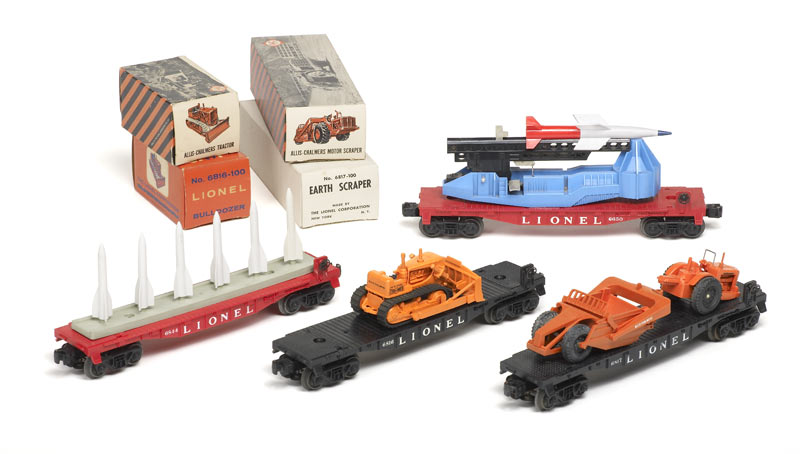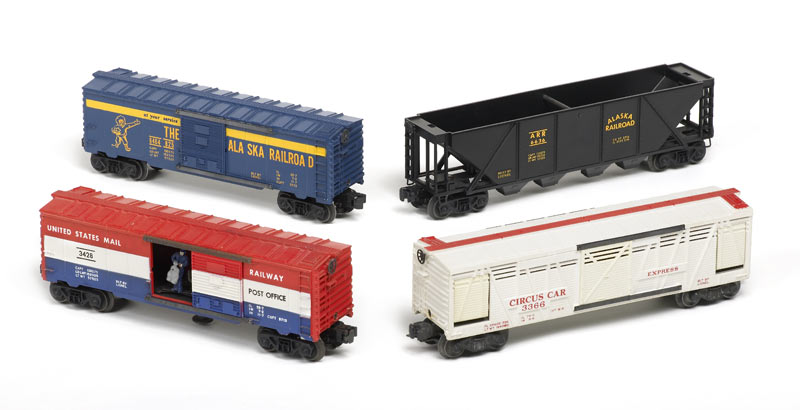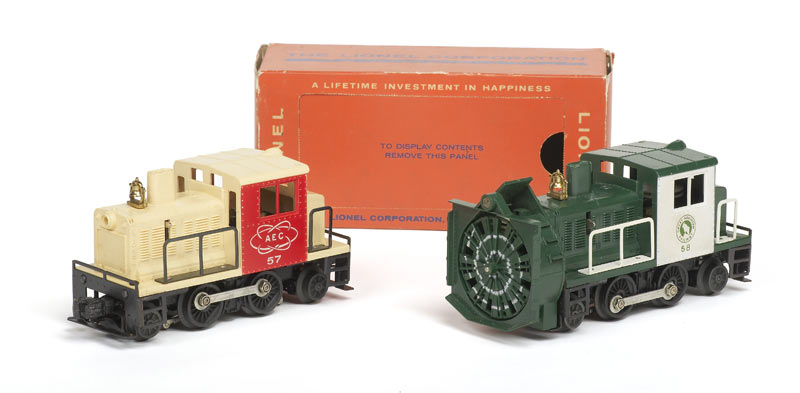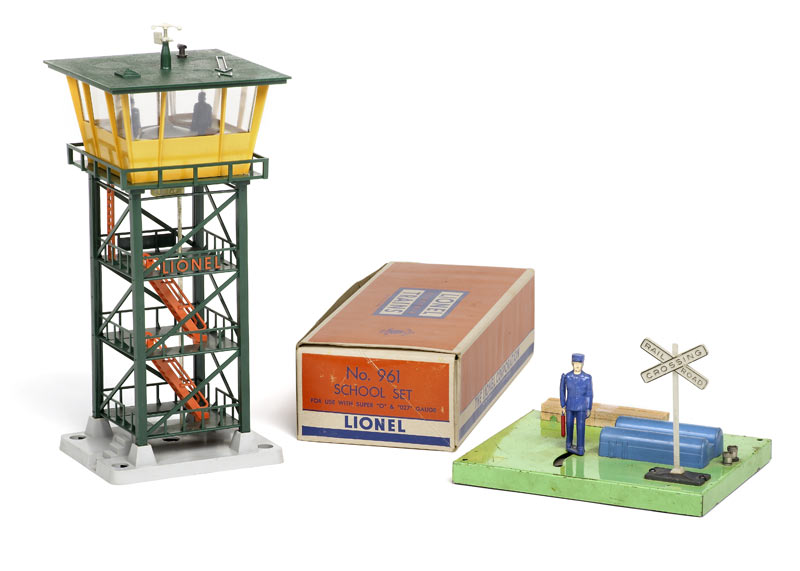Lionel’s separate-sale items and accessories for 1959
Readers of our article on Super O and O-27 outfits cataloged in 1959 (September 2009 issue) will remember that the company experienced some earth-shaking changes in 1959. The turmoil started at the top, as Joshua Lionel Cowen sold control to Roy Cohn, his great-nephew.
This confounding move by the elderly Cowen undermined the authority of his son, Lawrence, as president of Lionel. The latter soon felt compelled to step down. Even before he did so, changes were being made at the corporation’s headquarters in New York City and its plant in northern New Jersey. Longtime executives and supervisors were handed pink slips or pressured into resigning.
Somehow, as we pointed out, Lionel managed to bring out an impressive, innovative line of train sets for the holiday season. Counting the outfit advertised in the annual advance catalog, Lionel offered 13 different O-27 sets in 1959. Add in a dozen Super O outfits, and you can see why the line was a hefty one that year.
There seemed to be a set aimed at every household’s budget and every youngster’s interest. Prices ranged from $19.95 for the basic no. 1609 three-car steam freight train to $100 for either the no. 2544W Santa Fe Super Chief four-car passenger set or the no. 2545WS Norfolk & Western six-car space freight outfit.
The admission of Alaska as the 49th state in the Union inspired a Lionel train set in 1959. So did the public’s fascination with the Wild West and the Civil War centennial. Kids who were passionate about the exploration of space or the country’s latest military hardware found Lionel outfits designed to win them over.
Perhaps more telling about Lionel’s productivity in 1959 than the many different kinds of sets available was the fact that every one of its cataloged outfits featured at least one brand-new item, whether a locomotive or a piece of rolling stock (often an operating model). Lionel’s designers and production supervisors refused to cut back in the face of adversity.
The best of the new operating cars

Turning to the back of the consumer catalog for 1959, kids and their parents discovered an enormous array of separate-sale items. First came five transformers, with the No. 1044 at 90 watts leading up to the familiar ZW that packed 275 watts. Next were listed the different pieces of O and O-27 track and switches for sale, followed with an eye-opening assortment of Super O items.
If the young owners of a Lionel train impatiently skipped from the sets to the two pages crammed with pictures of freight and passenger cars available for separate sale, well, who could blame them? The diversity and quantity of these models was enough to overwhelm even the most jaded boys and girls.
Page 42 of the consumer catalog showed, under the heading “Operating Action-Cars,” 13 exciting models. Five of them had been part of Lionel’s product line for at least a year already: the Nos. 3356 operating horse car and corral (introduced in 1956), 3361 operating lumber car (1955), 3444 animated gondola car (1957), 3662 operating milk car (1955), and track cleaning car (1956).
The remaining eight entered the line in 1959. All but one of them was a component of at least one cataloged outfit. The Nos. 3419 operator helicopter launching car and 3540 operating radar scanning scope car fit into the space and military niche. The Nos. 3672 operating Bosco car was a variation of the milk car.
Two other new action cars can be seen as updated versions of the popular operating boxcar, namely, the Nos. 3428 operating U.S. mail car and 3434 chicken car with sweeper. By the way, it’s difficult to find a 3428 with an original blue mailbag, which suggests that Lionel equipped fewer cars with the combination of a gray figure and a blue bag than it did with the blue figure and gray bag mix.
Novel in their design and animation were Lionel’s nos. 3435 operating aquarium car and 3512 operating fireman and ladder car. Both are favorites today.
The No. 3366 operating circus car may not be especially new; after all, it was simply a revised version of the 3356 operating horse car. However, the eighth new action car stands out because it was not a component of any cataloged outfit.
New separate-sale freight cars

If you can believe it, Lionel illustrated or mentioned 40 freight cars on page 43 of its consumer catalog. Sixteen of those models were brand new, making them a testament to the creativity of Lionel’s designers and the determination of the company’s sales force to present a broad and diverse product line in 1959.
Several of these newcomers were intended to reinforce the space and military orientation that Lionel’s marketing had started to take. We can begin with the No. 6650 IRBM missile launching car, which probably deserves to be included with the operating cars. The 6650 should be paired with the No. 6470 exploding target car because the missiles it fired could leave this modified boxcar in pieces!
Three other new cars carried forward the military and space theme. All of them were flatcars that featured specialized loads: the Nos. 6819 flatcar with helicopter, 6823 flatcar with IRBM missiles, and 6844 missile carrying car.
Also noteworthy because they provided additional play value for kids were the nos. 6812 track maintenance car and 6814 first aid medical caboose. The latter can be considered a work caboose with a neat paint scheme and removable details. This willingness to update earlier models led to the introduction in 1959 of the no. 6670 derrick car, which succeeded the identical No. 6660 from 1958.
Lionel’s connection to Allis-Chalmers, which had led to the development of the No. 6519 car the previous year bore new fruit with the nos. 6816 and 6817. These red flatcars carried models of an Allis-Chalmers tractor dozer and a motor scraper, respectively. Scarce versions featured black flatcars. Even more desirable are separate-sale models (with the suffix “-100”) in special Allis-Chalmers boxes.
Still not done with “accessorizing” its flatcars, Lionel brought out the no. 6826 with evergreen branches serving as Christmas trees. The center section of the 3444 animated gondola was used to make up the No. 6821 flatcar with crates, and the No. 6825 had the arch trestle bridge available as an accessory (No. 332).
Remember the way Lionel capitalized on the admission of Alaska to the Union? Besides the No. 1611 four-car diesel freight outfit added to the O-27 line, it offered two new cars that were smartly decorated for the Alaska RR. The No. 6464-825 boxcar joined the well-received series of near-scale models that had been launched in 1953. A long open hopper, the No. 6636, expanded the roster.
Collectors have wondered for many years why Lionel’s decision makers decided against including either of these excellent cars in the 1611. The main reason, we believe, was price, as Lionel apparently spent enough time deciding that this set would be finally marketed with a $25 price tag. Including either car as an extra or replacement would have worked against that original assessment.
Naturally, Lionel’s sales executives were also free to sell these two Alaska RR cars as extra purchases to set owners, not to mention any buyer of its trains.
The final new entry into Lionel’s enormous list of freight cars was about as elementary as could be. The no. 6062 long gondola came lettered for the New York Central and packed with three orange plastic cable reels. Although shown as a red model in the consumer catalog, this car actually was unpainted black plastic.
Some notable veterans
As noted previously, 24 other freight cars were either illustrated or listed on page 43 of the consumer catalog. All of these had been cataloged for at least one year prior to 1959. Rather than describing all of them, we’ll concentrate on those models that merit attention and make 1959 an outstanding year at Lionel.
To start, all six of the red flatcars that had plastic military vehicles as their loads returned (Nos. 6803, 6804, 6806, 6807, 6808, and 6809). Lionel had bought these gray plastic tanks, trucks, and more from Pyro Plastics and introduced them in 1958. Enough of these items were left in stock for Lionel to offer them in ’59.
Still other flatcars carrying unique loads were available again in 1959. These included the Nos. 6175 with a rocket, 6424 with two autos, 6800 with an airplane, 6801 with a boat, 6802 with two girders, and 6818 with a transformer.
Nor can we overlook the Nos. 6519 Allis-Chalmers car and 6805 atomic energy disposal car, both introduced in 1958. That year also saw the debut of the Nos. 6434 illuminated poultry car and 6572 Railway Express Agency reefer car.
Going back farther in time were the Nos. 6414 Evans auto loader and the 6464-275 State of Maine boxcar, two favorites that entered the line in 1955. That year also heralded the first appearance of the Nno. 6517 Lionel Lines bay-window caboose. Older yet in 1959 were two other cabooses: Nos. 6357 and 6427.
The General gets an addition
Lionel had proudly announced its first old-time train when it heralded the General O-27 and Super O outfits in its catalogs. Available for separate sale were the No. 1872LT locomotive and tender combination and 1877 flatcar with six horses. In addition, the Nos. 1875W illuminated passenger coach with whistle and 1876 mail-baggage car from the Super O set could be purchased separately.
Not pictured amid the separate-sale items but noted all the same was a General passenger car not offered as a set component. The No. 1875 illuminated passenger coach provided consumers with a way to expand their frontier express.
By the way, Lionel continued to designate its Lionel Lines extruded aluminum streamlined passenger cars as models that could be purchased alone. The same was true with the brand-new blue-striped silver plastic cars lettered for the Santa Fe (Nos. 2412 Vista-Dome, 2414 Pullman, and 2416 observation car).
Missing, of course, were the three extruded aluminum streamlined cars that Lionel decorated with red stripes and Santa Fe nameplates. They could be acquired only by purchasing the top-of-the-line Super O 2544W Super Chief set.
The roster of motorized units grows

Kids and adults alike would have been captivated by the pictures of new models crowding pages 42 and 43. They couldn’t have missed the section devoted to new and returning motorized units. Since the no. 50 section gang car made its debut in 1954, Lionel kept adding to its roster, always to the delight of consumers.
The 50 remained part of the line for 1959, as did the nos. 53 Rio Grande snowplow and 55 “Tie-Jector” car. Both of the latter motorized units dated from 1957. Next came a trio of motorized units introduced the following year: the Nos. 52 fire fighting car, 54 track ballast tamper, and 68 executive inspection car.
What caught the eyes of all Lionel enthusiasts were three new units. First off was the No. 44 U.S. Army mobile missile launcher, a model combining the elements of an accessory with those of a small diesel and led Super O set No. 2527. Next up were the Nos. 57 AEC switcher and 58 Great Northern snowplow.
Room for some new accessories

Page 41 overflowed with new and old operating accessories. Even a casual look would have prompted youngsters to pause when they saw a few of the big items showing up again. These prominent mainstays included the Nos. 175 rocket launcher, 264 operating fork lift platform (with its special flatcar), 345 culvert unloading station (with its special gondola), and 464 operating lumber mill.
Then the boys and girls perusing the catalog would have spied the three largest and most interesting newcomers for 1959. The No. 470 IRBM missile launching platform appeared as though it could hold its own with the 175 and might even have complemented that accessory in a layout’s space setting.
Accompanying the 470 as the “recipient” of its missiles was the new No. 6470 exploding target car. However, Lionel suggested a second new item, the No. 943 exploding ammo dump, could also be blown apart by what the 470 launched.
The brand-new No. 192 railroad control tower was sure to enhance a yard or station scene. This animated accessory might fit in a space or military setting. Limited to a railroad was a fourth new item, the no. 1047 switchman with flag.
Searching more diligently enabled a reader to discover the other new accessories, all of which lacked action. The Nos. 76 set of three boulevard lamps, 121 and 131 tunnels, and 332 arch-under bridge rounded out the list of novelties.
Which low-end models were back? We count on pages 40 and 41 several lights and signals: the Nos. 71 lamp post, 140 banjo signal, 148 dwarf signal, 151 automatic semaphore, 153 automatic block signal, 154 flashing highway signal, 252 automatic crossing gate, and 253 automatic block control signal.
Miscellaneous items appropriate for any layout returned because there was always a demand for them. We’re talking about the Nos. 110 and 111 trestle sets, 114 newsstand with horn, 145 automatic gateman, 157 station platform, 214 girder bridge, 260 bumper, 309 yard set, 310 billboard set, and 321 trestle bridge.
Larger accessories that were no less familiar to veteran modelers returned. We’re talking about the nos. 128 animated newsstand, 195 floodlight tower, 197 rotating radar antenna, 199 microwave relay tower, and 494 rotary beacon.
Finally, builders of realistic, bustling stations or yards on a layout would have been quite pleased to glimpse once more the nos. 334 operating dispatching board, 350 engine transfer table and its extension, and 365 dispatching station.
Contributions from two other firms
The last point about Lionel’s train line for 1959 that we want to make relates to a trend initially observed the previous year. Company leaders continued to supplement what they offered with ancillary items from other manufacturers.
In 1958, the flatcar loads ordered from Pyro Plastics had boosted the appeal of Lionel’s electric trains to kids fascinated by the armed forces. To further broaden the line, executives had purchased quantities of plastic structure kits, figures, trees, automobiles, trucks, and other details from Bachmann Bros. Those items, part of Bachmann’s Plasticville line, were packaged specially for Lionel.
Interestingly, none of the 10 Plasticville sets that Lionel had cataloged in 1958 returned a year later. Instead, it featured eight new “Pike and Landscape Accessory Assortments” on page 40: the Nos. 953 figure set, 954 swimming pool and playground, 956 stockyard set, 960 barnyard set, 961 school set, 963 frontier set, 964 factory site set (the scarcest and most valuable), and 965 farm set.
Elsewhere on page 40, alongside the tried-and-true Nos. 40 hook-up wire and cable reel, 206 coal, 919 grass, 950 U.S. railroad map, and SP smoke pellets, were three more new items, all acquired from another hobby manufacturer. Life-Like provided the Nos. 971 box of lichen, 972 landscape tree assortment, and 973 complete landscaping set. It also produced the new tunnels (Nos. 121 and 131).
Taken as a whole, the agreements Lionel forged with Bachmann and Life-Like gave Lionel the opportunity to produce toy trains in its customary way while still having inexpensive items on the side to market and sell to produce a profit.
A great year after all
Putting aside our copies of the Lionel consumer catalog for 1959, we come away highly impressed with what the toy train maker was promoting. At a time of significant change within the corporation and uncertainty in the national toy market, executives managed to develop and advertise an expansive line.
From the outstanding Super O and O-27 outfits to all the separate-sale items, Lionel gave customers so much to consider. Add in the range of new and old accessories and additional items, and we imagine that hobbyists had virtually everything they needed to build a three-rail layout and have fun with their trains.
Missing from our account, of course, are the dozens of HO scale trains and accessories Lionel was developing in hopes of covering every niche in the model railroad hobby. Dynamism and imagination still characterized the firm in 1959, even after the earth-shifting changes that took place when Joshua Lionel Cowen decided to leave behind the enterprise he had founded at the turn of the century.













